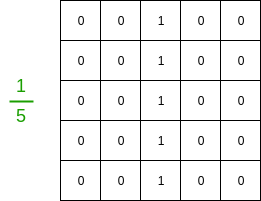OpenCV | Motion Blur in Python
Last Updated :
26 Aug, 2019
This article explains how to add blur to an image using OpenCV. Motion blur is a specific type of blur used to lend a directed blur effect to images.
The Motion Blur Filter
Applying motion blur to an image boils down to convolving a filter across the image. Sample 5*5 filter filters are given below.
Vertical:

Horizontal:

The greater the size of the filter, the greater will be the motion blur effect. Further, the direction of 1’s across the filter grid is the direction of the desired motion. To customize a motion blur in a specific vector direction, e.g. diagonally, simply place the 1’s along the vector to create the filter.
Code
Consider the following image of a car.

Code: Python code for applying a motion blur effect on the image.
import cv2
import numpy as np
img = cv2.imread('car.jpg')
kernel_size = 30
kernel_v = np.zeros((kernel_size, kernel_size))
kernel_h = np.copy(kernel_v)
kernel_v[:, int((kernel_size - 1)/2)] = np.ones(kernel_size)
kernel_h[int((kernel_size - 1)/2), :] = np.ones(kernel_size)
kernel_v /= kernel_size
kernel_h /= kernel_size
vertical_mb = cv2.filter2D(img, -1, kernel_v)
horizonal_mb = cv2.filter2D(img, -1, kernel_h)
cv2.imwrite('car_vertical.jpg', vertical_mb)
cv2.imwrite('car_horizontal.jpg', horizonal_mb)
|
Output
Vertical Blur:

Horizontal Blur:

Like Article
Suggest improvement
Share your thoughts in the comments
Please Login to comment...